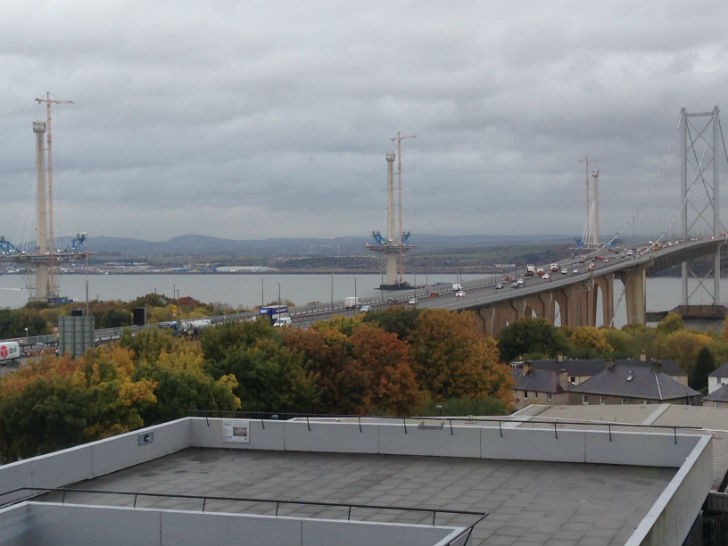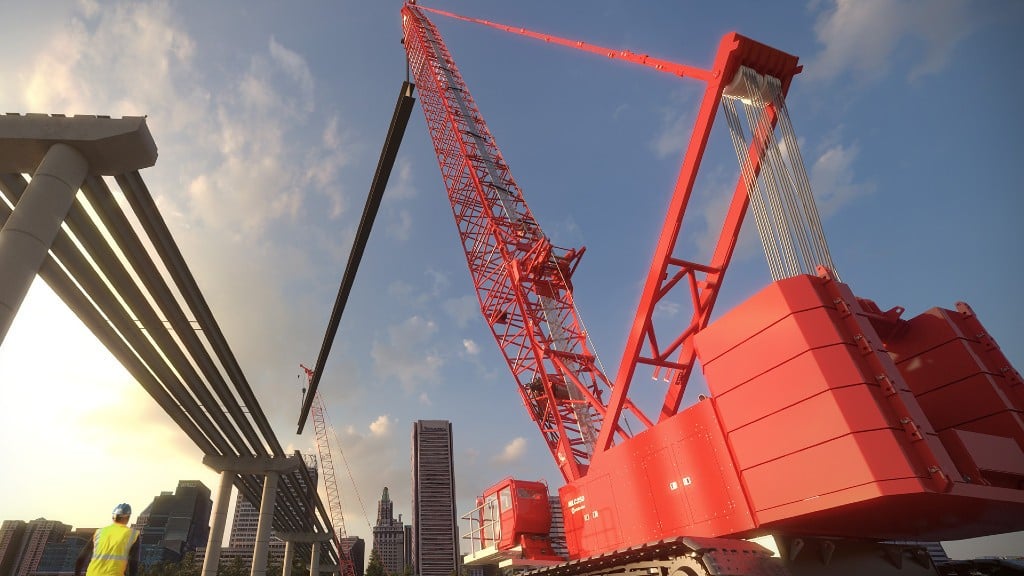
One of the largest infrastructure projects in Britain is underway in Edinburgh, and Liebherr, the Switzerland-based heavy equipment manufacturer, has been a key part of the project since its inception in the fall of 2011.
The Queensferry Crossing is a new bridge being built across the Firth of Forth to complement the existing Forth Road Bridge. The 51-year-old bridge is showing signs of deterioration, hence the decision by Transport Scotland to move ahead on a new bridge to be built alongside the existing one.
With a budget of between GBP 1.35 and 1.4 billion, the project is second only to Scotland’s largest-ever transportation project, the GBP 3 billion A9 Perth to Inverness road building program, which broke ground in September.
Once it is completed in late 2016, the 2.7-kilometre Queensferry Crossing will be the longest three-tower, cable-stayed bridge in the world, and the largest to feature cables that cross mid-span.
It is being built by Forth Crossing Bridge Constructors, a joint venture of Hochtief Construction AG, American Bridge International, Dragados SA and Morrison Construction.
Bridge construction
Three Liebherr 630 EC-H 40 tower cranes were used to construct the three towers, designated as south, central and north. The towers range in height from 202 to 210 metres. Hollow steel caissons weighing up to 1,200 tonnes were sunk almost to bedrock, then filled with concrete using a concrete barge. The pours occurred in sections, with each pour raising the height of the tower by 4 metres. The cranes working on each tower were also raised, in 5.8-m sections, eventually reaching a lifting height of 212 metres.
For the south tower, the volume of concrete poured underwater continuously amounted to 16,869 cubic metres - a world record.
Other interesting aspects of the bridge include:
- The bridge structure has an overall length of 2,633 metres including a cable-supported structure of 2,020m, the world’s second longest.
- The bridge design includes 14 spans, three concrete towers, two planes of stay cables, and a concrete steel tub/ concrete deck superstructure.
- Approach viaducts will connect the access roads on either side of the crossing to the bridge deck. On the southern approach two 3,000-pound viaducts are supported by eight V-shaped piers, and stretch 543 metres over water to where the bridge deck begins. The viaducts are moved into place using cables that control the level of the deck as it is pulled over each pier.
- Windshielding is expected to protect motorists from high winds in the Forth estuary and prevent bridge closures, which is a problem with the current Forth Road Bridge.
- The new bridge will contain 23,000 miles of cabling – enough to wrap around the moon three and a half times.
- The steel required for the bridge deck weighs 35,000 tonnes – the equivalent weight of 200 Boeing 747s.
Liebherr 630 EC-H 40 tower cranes
According to Liebherr, the 630 EC-H 40 Litronic tower cranes were designed for the high winds common in the Forth estuary, and engineered for the guying on the towers and the loads for the caisson foundations. The company says one of the main challenges of the project was the capacity to handle 30,000 tons of steel, with some high individual loads. The cranes are equipped with 36-m jib and lift up to 180 tons at the jib head. At a radius of up to 18 m, the cranes are designed for a 40-ton capacity.
“This configuration enables a particularly high-handling capacity with heavy loads. This lifting capacity is also supported by the 110-kW high-performance hoist gears which are in use on the project, and which guarantee fast lifting speeds,” Liebherr states.
Liebherr mobile and crawler cranes
Since the start of the project in November 2011, 12 different types of mobile telescopic and lattice boom cranes have been deployed on the site. Cranes from 400 to 500-tonnes have been used to lift components needed to construct the bridge. On average there are eight telescopic cranes on site each day, and in total there have been over 5,500 hire days. At least one model of almost every telescopic crane that Liebherr manufactures has been used on the project, according to the company. Smaller cranes are used for handling rebar, placing shuttering and carrying out general construction lifts. The larger cranes are called in to lift bridge deck segments and precast sections.
Two Liebherr LR 1300 crawler cranes have been deployed on the project. One is mounted on a barge situated in the river, which operates in support of the three Liebherr tower cranes. The second machine is based on the shore, and operates in support of the barge, loading out components that are taken to the base of the towers.
Company info
1015 Sutton Drive
Burlington, ON
CA, L7L 5Z8
Website:
liebherr.com/en/can/about-liebherr/liebherr-worldwide/canada/liebherr-in-canada.html



